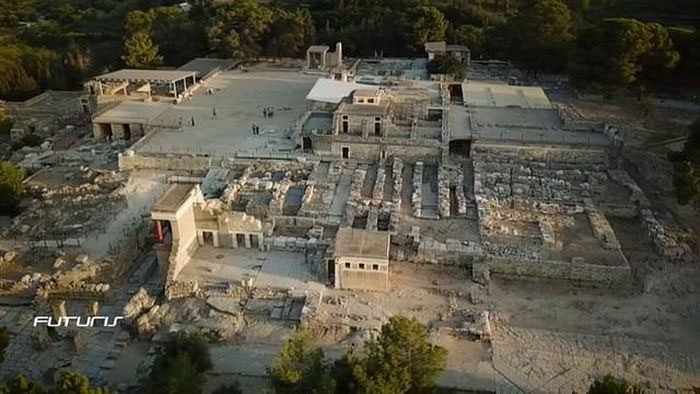Historical districts, such as those in Gubbio (Italy), are a source of local pride and a significant attraction for tourists from around the world.
According to Euronews, Gubbio is a stone city that boasts buildings of invaluable cultural and historical significance that must be preserved against the impacts of climate change.
To date, scientists continue to study the effects of climate change on ancient monuments. Research methods include satellite monitoring to detect ground shifts, followed by electromagnetic scanning to take localized samples from the walls using a pressure-sensitive drilling tool.
Mr. Giannis Grammatikas, a heritage conservation scientist at the University of Crete, explains the benefits of sampling to determine the hardness of the stone. Subsequently, chemical analysis of the drill cuttings will reveal the mineral composition of the stone, indicating potential erosion products—such as soluble salts.
The Gubbio building is currently affected by rain, which causes the stone walls to collapse. Rain weakens the mortar, leading to stones falling off. What remains of the city wall is still being closely monitored.

(Illustration: Euronews).
Mr. Francesco Tosti, a civil engineer, states that the rains have had a very negative impact on the buildings. Over the past three years, we have faced many extreme weather events, with rainfall significantly above average. This is affecting the wall structures.
The city of Gubbio is not the only place where scientists are working to understand the climate threat.
Climate change poses a particular threat to coastal areas, which are home to many historical sites, such as Koules, the Venetian fortress in Crete. Waves crashing against the 16th-century fortress continuously erode the walls. Changes in climate alter wind directions and wave patterns, affecting stone structures.
Restoring Architecture Amid Climate Change
At the seabed, researchers have installed sensors that continuously record water temperature and wave height. Twice a year, dives are conducted to collect data from these sensors.
Mr. George Alexandrakis, a coastal oceanographer at Forth-IACM, explains that we need this data for digital modeling to understand how waves impact the Koules fortress. We need to know the wave energy that the fortress receives. By combining this with past measurements, we can make short-term and long-term predictions and see how wave energy will evolve due to climate change.
After the data has been recorded, researchers place the sensors back on the seabed for an additional six months of monitoring. Some effects can be detected within the fortress. Scientists project powerful laser beams onto the wall surfaces for chemical analysis.
“Sodium chloride, salt accumulates on the wall surface. This is one of the impacts of the sea on the fortress. Water seeps into the walls and alters the chemical structure, significantly affecting the monument,” scientists analyze.
The local authorities have utilized the data collected by scientists to gain a better understanding of how to preserve heritage. Some express concern that due to climate change, old stone buildings will deteriorate faster, making preservation more costly.
“We have conducted a large-scale restoration campaign here. The goal is to continue monitoring the buildings to see when further measures need to be taken. The ultimate aim is to find ways to protect this monument for the next 500 years,” a local official stated.
For example, Knossos (Greece) – The First Palace of Europe was partially restored hundreds of years ago using reinforced concrete. The harsh climate is now weakening the cement, causing the iron to rust. To preserve this site, new types of cement and mortar are required.
Elisabeth Kavoulaki, an archaeologist at the Ephorate of Antiquities of Heraklion, mentions that the research project will help create new materials suitable for this special monument. This will aid us in better protecting our heritage.
Scientists have developed various new types of mortar, incorporating nano and micro-particles to enhance weather resistance, and a new type of cement that resembles the original used—but is less porous, preventing air from passing through easily.
Preserving Works of Art
Some renowned modern art museums will house paintings as well as sculptures. Some materials and experimental techniques used in contemporary art make the preservation of these works especially challenging.
The museum director, Karole Vail, explains that in 20th-century art, many new materials were employed. It is especially important to properly preserve these artworks for the public and future generations.
Today, priceless paintings are protected behind glass, but previously, these paintings were often directly exposed to the outside environment, accumulating dirt that is difficult to remove.
To address this issue, conservators have collaborated with scientists working on another European research project called Nanorestart. One of the paintings in the collection was cleaned using this specially developed hydrogel.
Unlike traditional methods such as cotton swabs, using hydrogel does not leave any fibers stuck to the paint surface during cleaning, is safe for the skin, and importantly, the gel removes dust quickly and effectively.
The potential of this nano-structured gel extends beyond art restoration— for instance, it can be used to remove coatings from various surfaces, which is a popular technical application.
From the climate changes impacting historically significant architecture to the ultra-fine dust particles clinging to valuable cultural artworks, scientists around the world are relentlessly striving to protect the world’s artistic and historical heritage to this day.


















































